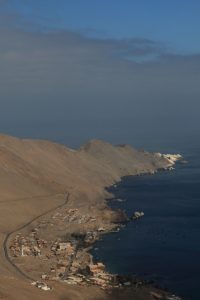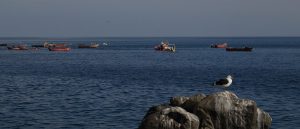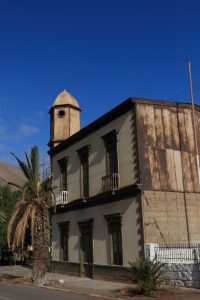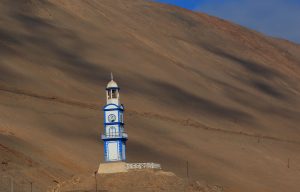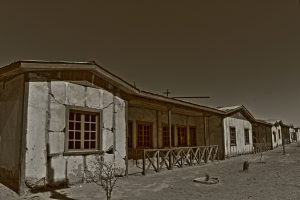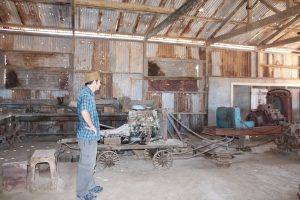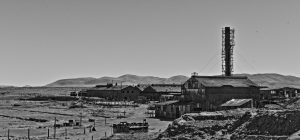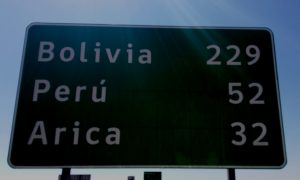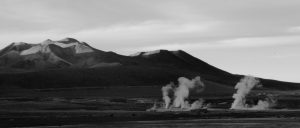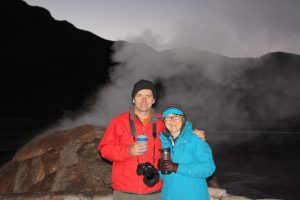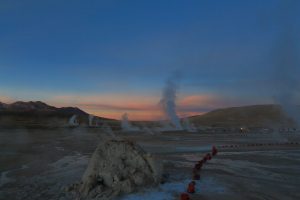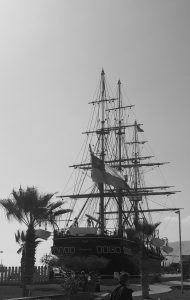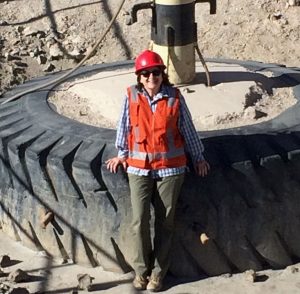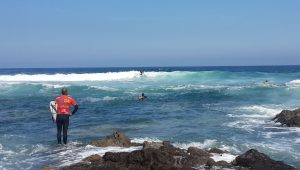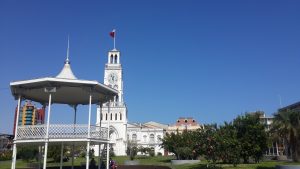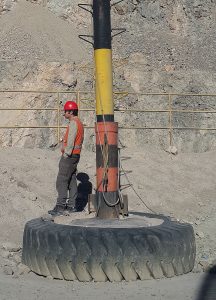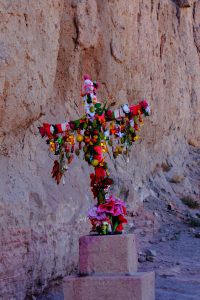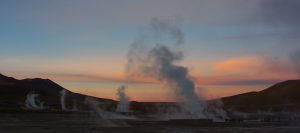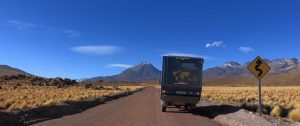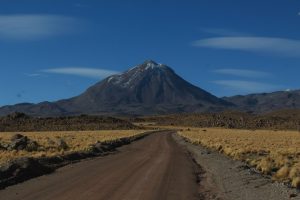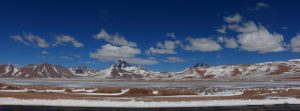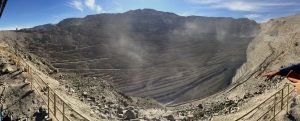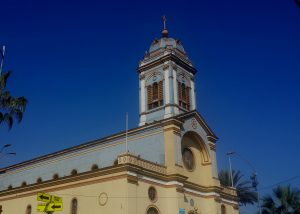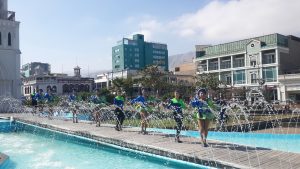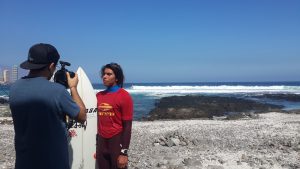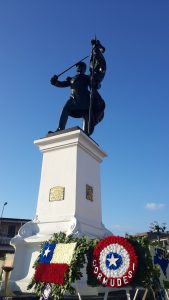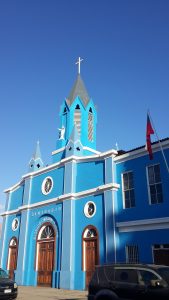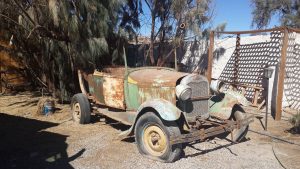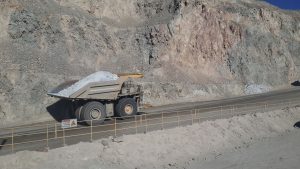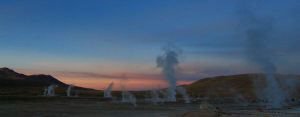The Atacama Desert sits between us and the Pacific Ocean in northern Chile. As we leave Argentina over the 4,800 m Jama Pass, we’re heading to the Atacama to check-out some weird sandstone formations and some geysers. Then it’s down to the coast for a bit of beach time before we head north and then finally east back up to the Andes (click here for Route Map).
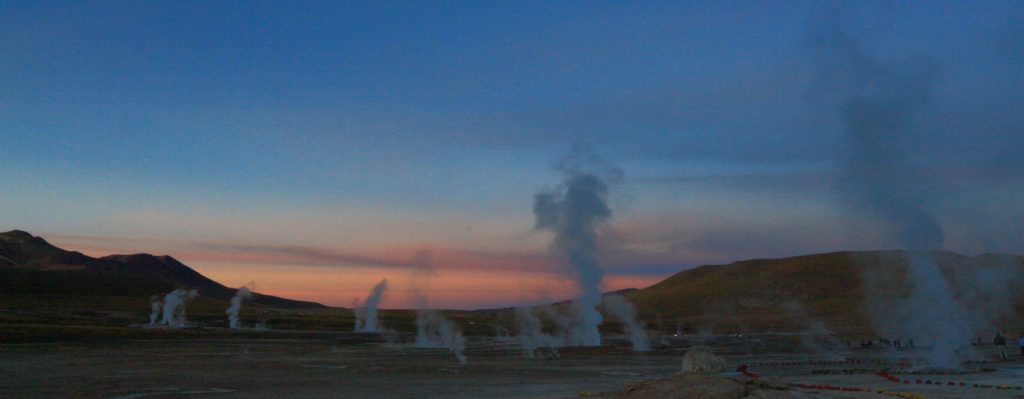
Atacama
The Paso Jama is the most northerly border crossing between Argentina/Chile and we’re not sad that this is the last time we will endure the slightly tedious process of Chilean entry formalities. The border guards are mostly pleasant, but the Chilean regulations on food import make it difficult to manage the overlanding kitchen when hopping the border on a regular basis. Over numerous entries to Chile we have found the regulations to be inconsistently enforced; you can never be sure when half the contents of your fridge and store cupboard are going to be confiscated! Perhaps when we reach the central american borders with their notoriously bureaucratic systems and corrupt officials, we will look back on the Chilean borders with fond memories of easy-passage!
Anyway… we’re now into Chile again and the Paso Jama sets a new altitude record for us of 4,800m/15,750 ft! It wasn’t snowing, but the snow on the slopes aside the road was blowing in the strong cross-winds to form drifts across the otherwise good quality tar road. This crossing of the Andes is yet another beautiful journey, but at the top it’s a bracing -4C outside with fierce winds; we decide to forgo the experience of getting out of Cuthbert to inspect the unusual rock formations that we pass. The climb-gradient from the border-post to the top of the Pass is so gentle that you don’t really notice the altitude. However, the same cannot be said for the descent on the other side! The road drops some 2,000 m in around 10km.
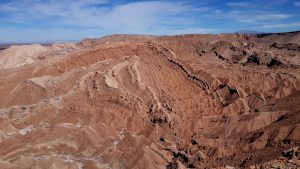
Hmmm… Moon? Or Death?
Arrival in the small town of San Pedro de Atacama is a pleasant surprise: first, a warming 20C (the first t-shirt weather we’ve had in a while!) and secondly, a 3G phone signal for some internet! After the rubbish mobile data network in Argentina, it is a treat to get back to Chile’s 21st Century network data capability! San Pedro is a likeable, laid-back but very touristy little town serving some of Chile’s top attractions: El Tatio Geysers, Valle de la Luna (Valley of the Moon) and Valley del Muerte (Valley of Death). Goes without saying… we have to check these out.
The Valley of the Moon and the Valley of Death are easy to visit from San Pedro. Unsurprisingly given their proximity to each other, they looked remarkably similar and afterwards from our photos we couldn’t work out which was which! They were both nice, but neither really lived up to our increasingly high-bar expectations (maybe we should stop reading the travel books raving about these places so that we can approach things with a more open mind). We have concluded it can only be their close proximity to San Pedro that makes these valleys the much visited attractions that they are. In our travels across Chile and Argentina we have seen equally (and even much more) beautiful scenery in random locations, little visited by tourists. Anyway… we’re glad we’ve been there (as they say… ‘Got the Tick’), maybe we’ll see some more equally ‘nice’ stuff as we head further across the Atacama to the ocean.
Old Geysers
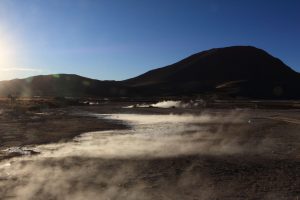
With the day-time wind
Also much visited from San Pedro, but far less convenient to reach, are the geysers at El Tatio sitting high Andes at just over 4,300m. They are said to be most spectacular at dawn, but as it’s a two hour drive up a winding road, the tour-vans leave San Pedro at an un-godly 04:00 hours (yes folks, that’s four in the morning!!) to reach the geysers in their best light. We like an adventure, but we’re certainly not up for those kind of ridiculous-o’clock shenanigans! We’ve decided to park up at El Tatio for the night so that we can roll out of bed in the morning ready to inspect the geysers at first light.
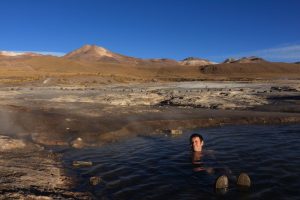
Mad boy in the pool
We reached El Tatio by late afternoon. The sun was still warm so Marcus decided to take a dip in the hot-springs pool. Nice warm water, but with an ambient air temperature of around 5C (and that’s without the wind-chill factor) I declined the opportunity. As the sun set, the temperature fell and two other camper-vans parked-up alongside us. Both of these were holiday rental vans and neither had any internal heating! Eeeish! At dawn it was -8C up there. We wondered… are they brave or stupid? You decide!
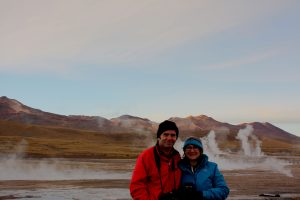
At dawn we wrapped up warm and went out with a hot mug of tea in hand to check out the geysers. During the day the wind disperses the geyser steam and it flows flat across the ground. But at dawn the air is calm and the steam from each of the venting geysers streams vertically up as the sunrise catches it. The curious thing was that at that altitude, the sun-rise and the transition from darkness to daylight happens almost instantly. There is precious little time within which to see the steam against a colourful day-break sky and we didn’t manage to take the many stunning photos that we had hoped. Nevertheless (and despite the cooooold) it was indeed a bit special. Whilst it would have been nice to witness it all in solitude, the site is big enough that the few tour-vans of back-packers did not really spoil the experience for us.
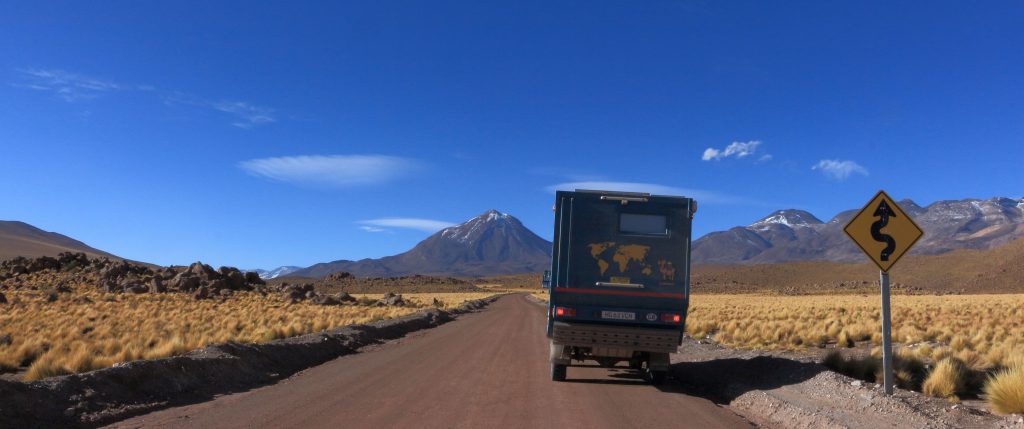 Sometime later we met some Canadian travellers who, having previously visited geysers in Iceland, decided not to include El Tatio on their tour of Chile. This we can wholly understand. The Chilean geysers gurgle and steam, but very rarely spout the huge plumes of spectacular hot water that we have seen in pictures from Iceland. But if, like us, this is your first experience of a spouting geyser, then it’s worth the effort of the de-tour as you pass through the Atacama.
Sometime later we met some Canadian travellers who, having previously visited geysers in Iceland, decided not to include El Tatio on their tour of Chile. This we can wholly understand. The Chilean geysers gurgle and steam, but very rarely spout the huge plumes of spectacular hot water that we have seen in pictures from Iceland. But if, like us, this is your first experience of a spouting geyser, then it’s worth the effort of the de-tour as you pass through the Atacama.
Mine all mine
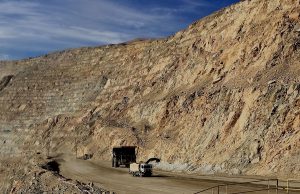
12 T truck & a 250 T mining monster-truck!
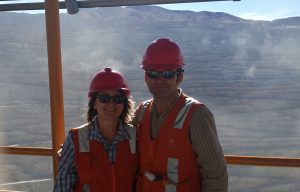
Ready to mine
Back down the hill in the Atacama town of Calama, we visited the world’s largest open-cast copper mine at Chuquicamata. As a PR exercise for the local community, the mining company takes tours to learn about the copper mining and production process. On the tour we donned the trendy day-glo jackets and hard-hats to go into ‘the hole’ to see the diggers and giant monster-trucks doing their thing. Well… we say ‘hole’… it’s a bit more than just a ‘hole’ – it’s 1,000m deep, 4,300m long and 3,000m wide. The awesome scale of this thing has to be seen to be believed. The monster-trucks each carry over 250 tonnes of rocks to the surface! A fascinating and educational afternoon.
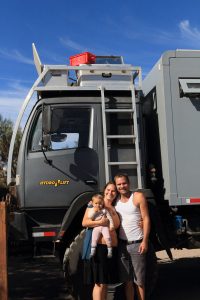
Anna does over-landing in style!
Whilst we’re in Calama we take the opportunity for a bit of over-landing-admin (supermarket stocking-up, laundry, blah, blah, blah) and it is here that we meet Anna, our youngest ever over-lander! Gorgeous Anna is just 15 months old and is escorting her parents Toby and Kristina on a tour of South America in a marvellous top-notch camper-truck. She is a happy smiling little soul; doesn’t seem to get stressed about anything and takes the whole over-landing experience in her stride. Some grown-up over-landers could usefully take a leaf from Anna’s book!
Navy Day Iquique
From Calama we head across the Atacama Desert to the edge of the plateau before suddenly dropping steeply to the coastline. The drive across the Atacama is stark and not the most attractive in the world; it reminds us of our journeys from Qatar through the desert scrub-lands of Saudi Arabia to UAE when we lived in that part of the world. We conclude that the clue to the similarity could possibly lie in the word ‘desert’ 🙂 When we reach the Pacific shore at Tocopilla (winner of Cuthbert’s ‘Ugly Ports-R-Us’ Award 2016) and park-up in a rocky cove for the night, it is a welcome change to smell the sea air and to fall asleep to the sound of waves crashing. It’s a while since we have spent any time by the ocean and we enjoy the next 250km drive north along the scenic rocky coast to the city of Iquique. The birdlife along this coastline is extraordinary! We have little clue as to the identity of the many varied species, but there are lots of them whatever they are!
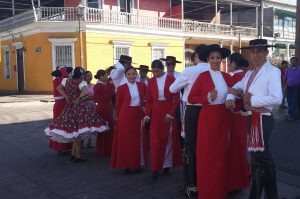
Locals dressing up for Navy Day – not exactly ‘on-theme’!
Iquique is one of Chile’s key naval ports and we arrive in town on the weekend of national Navy Day, celebrating the naval Battle of Iquique on 21st May 1879. The battle with neighbouring Peruvian ships was part of the War of the Pacific and took place just off the coast here. It is celebrated with military parades and less formal dressing-up by the locals. Iquique is also one of Chile’s surfing centres, so an extra dimension to the sea-faring themed celebrations is the ‘Heroes of May’ national surfing competition. You may be just as disappointed as we were to learn that we arrived in town too late to register as competitors. Obviously had we arrived in time, we would have been out there with them, but we had to settle for more relaxing activity of spectating from the beach 😉
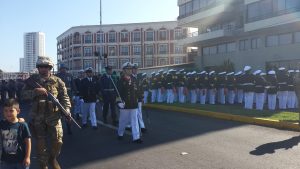
Bit more ‘on-theme’ for Navy Day
Another mission in Iquique was for Marcus to do a bit of overdue maintenance on Cuthbert. For over a year now Cuthbert has been carrying a tiny leak in the radiator which has not concerned us so far. We think this may have been caused by some stone-damage back in Africa, but it’s now starting to get a bit worse and probably best to be fixed before heading into the high altitude/remote areas of Bolivia. The necessary parts are available from the Iveco garage in Iquique and we find a nice camp-site to park-up so that Marcus can do the work. There are some other friendly over-landers from Switzerland parked-up there, so we have a pleasant stay and before we know it, a week has gone by!
To Arica
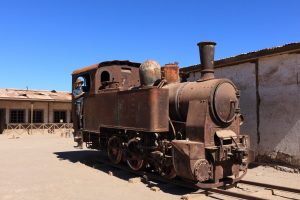
Tuck’s Train – ghost-town Humberstone
North of Iquique the road diverts in and out from the coastline and we enjoy the ocean views when we can get them. On the way we visit the spooky ‘ghost town’ and abandoned saltpetre works of Humberstone; we also find some pretty remote and quiet fishing villages. Scattered along the coast are numerous memorials to the aforementioned War of the Pacific and deteriorating cemeteries from that era, but gruesomely in the tiny port of Pisagua there is also a much more recent mass grave and memorial – to the victims of the brutal Pinochet era in the 1970/80s.
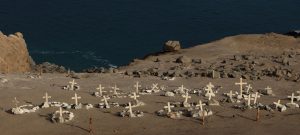
Pisagua – War of the Pacific 1879 Cemetery
Gruesome memorials aside, Pisagua is a pleasant stop-over; a curious combination of an old derelict nitrate port and a current thriving fishing village. The shells of the old ruined buildings stand empty and deteriorating, dispersed between more modern, busy and colourful facilities. This mix of dereliction and activity makes for a curious atmosphere in the village, but the people were welcoming and it has a lovely beach.
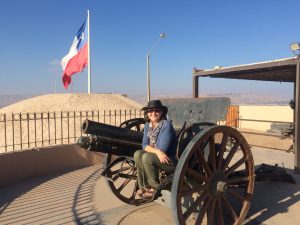 Finally, we reach the most northerly town in Chile just 20 km before the Peruvian border: Arica. It’s a larger town than we expected, but it’s still got a rather laid-back beach-surf-vibe. There are a lot of young people who like to party-on-down in the wee small hours. We can say this with some confidence because we spent two nights parked up in two different places, each of which appeared peaceful in the evening but then sprang to life with booming ghetto-blasters (does anyone still have these or are we showing our age here?) around midnight. Arrrgh… it was annoying, but all very good natured, no aggro or anything. Perhaps we should have joined them! 🙂
Finally, we reach the most northerly town in Chile just 20 km before the Peruvian border: Arica. It’s a larger town than we expected, but it’s still got a rather laid-back beach-surf-vibe. There are a lot of young people who like to party-on-down in the wee small hours. We can say this with some confidence because we spent two nights parked up in two different places, each of which appeared peaceful in the evening but then sprang to life with booming ghetto-blasters (does anyone still have these or are we showing our age here?) around midnight. Arrrgh… it was annoying, but all very good natured, no aggro or anything. Perhaps we should have joined them! 🙂
Anyway, after a bit of sight-seeing around town (including a fascinating archaeological site of some locally found mummies that pre-date their Egyptian counterparts by over 2,000 years!) it’s time to move back to the mountains. If we keep going north we’ll enter Peru, but we have so far by-passed landlocked Bolivia. To rectify this, we need to head in-land east-wards for a while.
Bolivia bound
It’s a climb of over 4,000 m from the coast to the border. There is a main road but it’s a popular transit route for lorries between La Paz and the Chilean coastal ports; apparently around 500 trucks per day plough this route. We take a quieter back-road as far as we can, but eventually we’re forced to join the trucks to get to the border crossing. The road shows signs of wearing down from the many heavy trucks, but it is nowhere near a bad as the truck routes across East Africa that we drove last year, linking the landlocked central African countries with the ports of Tanzania and Kenya! Those were far, far worse than here and we are relieved not to have to re-live that ‘Road from Hell’ experience!
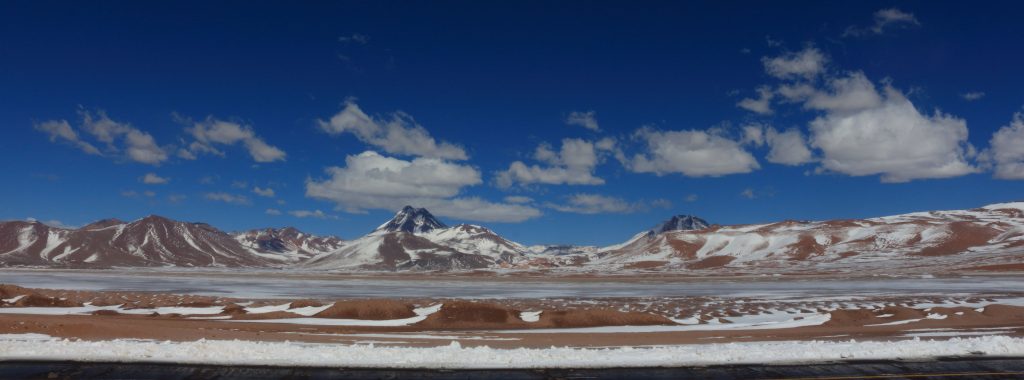
Reaching this far-northern border of Chile is something of a milestone for us. We have now travelled the full length of what is probably the longest country in the world. It’s around 4,300 km in a straight line, from Tierra del Fuego to here, and we have driven anything but a straight line! We have found most of Chile to be a very modern 21st Century country. During our stints in Argentina, whenever we needed to buy a particular something, it was always “Wait ‘til we get back to Chile!”. From Waitrose chocolate biscuits to spare parts for Cuthbert, we found pretty much everything we wanted in Chile. It has history, culture, awesome scenery and friendly, welcoming people. Although it lacks the vast ‘rough and raw’ of Argentina, we have loved our time in Chile and Easter Island was certainly one of the highlights of the trip so far for us.
So now we’re saying ‘Cheerio’ to Chile! Next adventure is in a new country for Cuthbert: Bolivia!
Link to next blog: Beginning Bolivia Link to full South America Blog
Northern Chile Gallery
- Mad boy in the pool
- Anna does over-landing in style!
- With the day-time wind
- Ready to mine
- Hmmm… Moon? Or Death?

